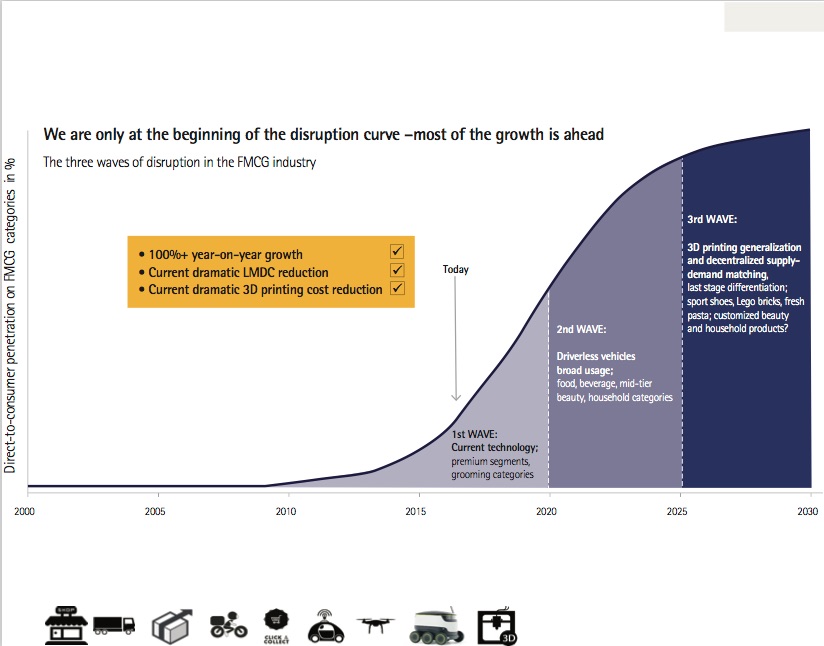
For companies to be and remain competitive in the future, they will have to increase the speed with which they innovate and create new digital initiatives
Major changes ahead
The Consumer and Retail industry will change more over the next 20 years than over the last 200 years. First on the list is the drive towards increasing personalized, one-to-one marketing with companies leveraging data analytics to deliver individualized messages and product offerings. Examples are chatbots or intelligent in-store signage that adapts its message to he consumer depending on age and gender. Another example is autonomous vehicles drastically reducing last-mile-delivery costs will open up an era of mass direct-to-consumer disruption, and 3D printing will most likely offer decentralized supply and demand matching. And in terms of value chain transparency, blockchain will push consumer information to a new level: whether the manufacturer wants it or not, there will be no secrets left for the consumers in the ingredients list! The Internet of Things (connected products) will revolutionize retail stores with self-service checkouts, and will also provide a unique opportunity for companies to build a consumer eco-system and diversify their stream of income via data, services, and hardware. Each of those dynamics in isolation has the potential to drastically change any particular industry. Connected together, they will revolutionize all industries.

For all the technological advances, the brick-and-mortar store looks likely to live on. However, there will be a huge change in role that the brick-and-mortar store has to fulfil. The focus will no longer be on selling specific items stored in a specific location – consumers will be able to finish the purchasing process at home or online via mobile apps. It will instead lay on consumer advice, personalization of the product and offering additional services. In this light, the size and number of physical sales outlets and employees look likely to decrease. As a result, companies will have to adapt to this new digital era by not only changing its workforce but also by adapting internal structures and its organization.
Digital disruption and leadership
For companies to be and remain competitive in the future, they will have to increase the speed with which they innovate and create new digital initiatives. Success is not in predicting a certain future, but in structurally transforming the business to deal with an ever uncertain future:
-Future leaders will have to focus strongly on creating the ‘new and different’. In return, this requires more risk-taking compared with today.
-In order to sustain in the ever-changing environment, leaders need to learn and adapt continuously. The ability to apply past lessons to new situations and handle first-time situations will be key.
-Future challenges will not be easy. Leaders who are successful in the future will not be afraid but motivated by tough obstacles.
Successful business doesn’t start with digital strategy but rather education
The main challenge for the Consumer and Retail industry – as for other industries – will not lay in adapting business strategy to digital disruption but to make the culture and organization evolve:
-Digital education and continuous learning: As a first step in the learning journey, leaders
must learn about the disruptions to come and the ever-changing new challenges they may represent.
-Consumer-centricity: Employees need to learn that the consumer is at the centre of the business and that also requires deep understanding of the massive change in consumer behaviour as a result of ongoing digitization.
-Transformative Purpose: At the beginning «of a transformative journey stands the
definition of a company’s transformative purpose. As part of a company’s vision, this strongly impacts employee culture and steers digitalisation initiatives.
-An entrepreneurial, experimentation culture: Fostering this type of culture means implementing empowered, multi-disciplinary, decentralized teams.
The digital journey will require a drastic new, strategic approach to talent management that is built on a deep understanding of the complexity and diversity of the talent pool. On the one hand, the pace of change will accelerate – new jobs and roles will emerge, and some others disappear. On the other hand, requirements will change – talents that got the companies ‘here’ may not get them ‘there’ and to the future. As such, attracting and retaining employees cannot be the sole responsibility of HR. Moreover, recruitment and retention of top executives must be a top priority. Getting the right mix of talents is essential too: companies must combine internal talent determined to be ‘digitally ready’ with select, externally recruited, ‘born-digital’ talent from pure-play Web 2.0, IoT organizations.
The ‘war’ for talents will further intensify and increased employee mobility will be tough on companies without clear employee value propositions. Thus, companies need to be aware of what attracts people – the inspiring vision/purpose of a company, flexible employment, challenges and autonomous working opportunities and the moving away from skills building to aligning capabilities with the strategic objectives of the business.
Strategy: risks and challenges
Strategies written today can only incorporate what we know at the moment. However, what will shape and transform the industry is most likely not yet out there! Change is constant and companies and leaders therefore need to be aware of the driving innovations that will shape the industry in the future – new technologies, changing consumer preferences, and business model innovations.
Entering into e-commerce and direct-to-consumer requires large investments as well as patience. Manufacturers and retailers should not risk pumping money into ‘digital’ without a clear purpose and thought-through target consumer value proposition. And when investing, retailers and manufacturers should remember their brick-and-mortar stores – it is important to create a consumer experience to still make it worth going to an offline store. A digital strategy therefore needs to incorporate both the online and the offline worlds. Most companies are already fully aware that consumer data has enormous potential. Getting and owning this data will over time become even more important. However, companies need to take full advantage of analysing this data to get to know the consumer and shape the proposed value proposition to the consumer’s needs. Consumer data is not only key in the online sphere – but needs to be leveraged both offline and online.

